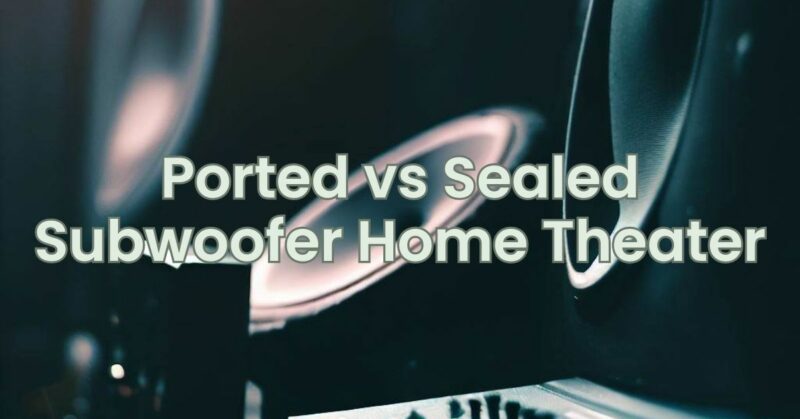When setting up a home theater system, incorporating a powerful and immersive low-frequency response is crucial for a cinematic experience. Subwoofers play a significant role in reproducing deep bass frequencies, but you may come across two common designs: ported and sealed. In this article, we will compare ported and sealed subwoofers, exploring their characteristics, advantages, and considerations to help you make an informed decision for your home theater setup.
Ported Subwoofers:
- Design: Ported subwoofers feature an additional port or vent on the enclosure, allowing the internal air to flow in and out. This port contributes to the subwoofer’s overall performance by enhancing the low-frequency response.
- Bass Response: Ported subwoofers are known for their ability to produce louder and more extended low-frequency output compared to sealed designs. The port assists in reinforcing the bass response, resulting in deeper and more impactful bass notes.
- Efficiency: Ported subwoofers tend to be more efficient than sealed models, meaning they can produce higher sound levels with less power. This efficiency makes them well-suited for larger rooms or spaces where high-volume levels are desired.
- Trade-offs: While ported subwoofers excel in delivering deep bass, they may sacrifice a bit of precision and transient response compared to sealed models. Additionally, their design requires careful consideration of room placement to optimize performance, as the ported design is more sensitive to positioning and room acoustics.
Sealed Subwoofers:
- Design: Sealed subwoofers feature a fully enclosed enclosure without any additional ports or vents. The design is simpler, relying on the air trapped inside the enclosure for controlling the speaker’s movement.
- Bass Response: Sealed subwoofers are known for their tight and controlled bass response. They offer excellent transient response, accurately reproducing fast-paced bass notes and providing a more precise and detailed low-frequency performance.
- Size and Placement Flexibility: Sealed subwoofers are generally more compact than ported models, making them easier to integrate into different room sizes and layouts. Their design is less sensitive to placement, allowing for more flexibility in positioning within the room.
- Power Handling: Sealed subwoofers tend to handle power more efficiently, making them an ideal choice for those who prioritize accuracy and musicality over sheer output volume.
Choosing the Right Subwoofer:
When deciding between a ported or sealed subwoofer for your home theater, consider the following factors:
- Room Size and Layout: Ported subwoofers may be better suited for larger rooms, while sealed subwoofers can work well in smaller or more acoustically challenging spaces.
- Desired Sound Characteristic: If you prefer a more impactful and booming bass experience, a ported subwoofer might be the right choice. If accuracy and precise bass reproduction are more important to you, a sealed subwoofer could be the better option.
- Personal Preference: Ultimately, your personal listening preferences and the overall sound balance you want to achieve in your home theater system play a crucial role. It’s recommended to audition both types of subwoofers, if possible, to determine which one aligns best with your preferences.
Choosing between a ported or sealed subwoofer for your home theater depends on various factors, including room size, desired bass response, and personal listening preferences. Ported subwoofers offer deeper and more powerful bass output, making them suitable for larger spaces, while sealed subwoofers provide tighter and more controlled bass reproduction, ideal for smaller rooms. Consider the trade-offs in terms of placement flexibility, power handling, and room interaction when making your decision. Ultimately, selecting the right subwoofer design will enhance your home theater experience, immersing you in the rich and impactful low-frequency performance you desire.


